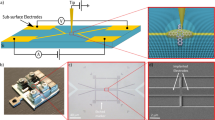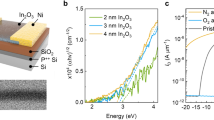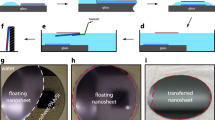Abstract
One of the major challenges towards scaling electronic devices to the nanometre-size regime is attaining controlled doping of semiconductor materials with atomic accuracy, as at such small scales, the various existing technologies suffer from a number of setbacks. Here, we present a novel strategy for controlled, nanoscale doping of semiconductor materials by taking advantage of the crystalline nature of silicon and its rich, self-limiting surface reaction properties. Our method relies on the formation of a highly uniform and covalently bonded monolayer of dopant-containing molecules, which enables deterministic positioning of dopant atoms on the Si surfaces. In a subsequent annealing step, the dopant atoms are diffused into the Si lattice to attain the desired doping profile. We show the versatility of our approach through controlled p- and n-doping of a wide range of semiconductor materials, including ultrathin silicon-on-insulator substrates and nanowires, which are then configured into novel transistor structures.
This is a preview of subscription content, access via your institution
Access options
Subscribe to this journal
Receive 12 print issues and online access
$259.00 per year
only $21.58 per issue
Buy this article
- Purchase on Springer Link
- Instant access to full article PDF
Prices may be subject to local taxes which are calculated during checkout





Similar content being viewed by others
References
Peercy, P. S. The drive to miniaturization. Nature 406, 1023–1026 (2000).
Claeys, C. Technological challenges of advanced CMOS processing and their impact on design aspects. VLSI Design 2004, 275–282 (2004).
Xiong, S. & Bokor, J. A simulation study of gate line edge roughness effects on doping profiles of short-channel MOSFET devices. IEEE Trans. Electron Devices 51, 228–232 (2004).
Jones, E. C. & Ishida, E. Shallow junction doping technologies for ULSI. Mater. Sci. Eng. 24, 1–80 (1998).
Lundstrom, M. Moore’s law forever? Science 299, 210–211 (2003).
Wong, P. H.-S. Beyond the conventional transistor. Solid-State Electron. 49, 755–762 (2005).
Chau, R. et al. Silicon nano-transistors and breaking the 10 nm physical gate length barrier. Device Research Conf. 2003, 123–126 (2003).
Lu, W. & Lieber, C. M. Semiconductor nanowires. J. Phys. D 39, R387–R406 (2006).
Wang, D., Sheriff, B. & Heath, J. R. Silicon p-FETs from ultrahigh density nanowire arrays. Nano Lett. 6, 1096–1100 (2006).
Chen, P. et al. Atomic layer deposition to fine-tune the surface properties and diameters of fabricated nanopores. Nano Lett. 4, 1333–1337 (2004).
Parviz, B. A., Ryan, D. & Whitesides, G. M. Using self-assembly for the fabrication of nano-scale electronic and photonic devices. IEEE Trans. Adv. Packag. 26, 233–241 (2003).
Chang, L. & Wong, P. H.-S. Diblock copolymer directed self-assembly for CMOS device fabrication. Proc. SPIE 6156, 1–6 (2006).
Song, Y. H. et al. A novel atomic layer doping technology for ultra-shallow junction in sub-0.1 pm MOSFETs. IEEE IEDM 1999, 505–508 (1999).
Kalkofen, B., Lisker, M. & Burte, E. P. Phosphorus diffusion into silicon after vapor phase surface adsorption of phosphine. Mater. Sci. Eng. B 124–125, 288–292 (2005).
Agrawal, A. IEEE Int. Conf. on Ion Implantation Technology Proceedings 2000 293–299 (Alpbach, Austria, 2000).
Privitera, V. Ultra-low energy ion implantation of boron for future silicon devices. Curr. Opin. Solid State Mater. Sci. 6, 55–65 (2002).
Moon, C.-R. et al. Application of plasma-doping technique to reduce dark current of CMOS image sensors. IEEE Electron. Dev. Lett. 28, 114–116 (2007).
Sieval, A. B., Vleeming, V., Zuilhof, H. & Sudholter, E. J. R. An improved method for the preparation of organic monolayers of 1-alkenes on hydrogen-terminated silicon surfaces. Langmuir 15, 8288–8291 (1999).
Filler, M. A. & Bent, S. F. The surface as molecular reagent: Organic chemistry at the semiconductor interface. Prog. Surf. Sci. 73, 1–56 (2003).
Linford, M. R. & Chidsey, C. E. D. Alkyl monolayers covalently bonded to silicon surfaces. J. Am. Chem. Soc. 115, 12631–12632 (1993).
Webb, L. J. & Lewis, N. S. Comparison of the electrical properties and chemical stability of crystalline silicon(111) surfaces alkylated using grignard reagents or olefins with Lewis acid catalysts. J. Phys. Chem. B 107, 5404–5412 (2003).
Bentzen, A., Schubert, G., Christensen, J. S., Svensson, B. G. & Holt, A. Influence of temperature during phosphorus emitter diffusion from a spray-on source in multicrystalline silicon solar cell processing. Prog. Photovolt. Res. Appl. 15, 281–289 (2007).
Susa, M., Kawagishi, K., Tanaka, N. & Nagata, K. Diffusion mechanism of phosphorus from phosphorous vapor in amorphous silicon dioxide film prepared by thermal oxidation. J. Electrochem. Soc. 144, 2552–2558 (1997).
Byon, K., Thanm, D., Fischer, J. E. & Johnson, A. T. Synthesis and postgrowth doping of silicon nanowires. Appl. Phys. Lett. 87, 193104 (2005).
Lieber, C. M. & Wang, Z. L. Functional nanowires. Mater. Res. Soc. Bull. 32, 99–108 (2007).
Huang, Y. et al. Logic gates and computation from assembled nanowire building blocks. Science 294, 1313–1317 (2001).
Patolsky, F., Timko, B. P., Zheng, G. & Lieber, C. M. Nanowire-based nanoelectronic devices in the life sciences. Mater. Res. Soc. Bull. 32, 142–149 (2007).
Beckman, R. A. et al. Fabrication of conducting Si nanowire arrays. J. Appl. Phys. 96, 5921–5923 (2004).
Zhu, Z.-T., Menard, E., Hurley, K., Nuzzo, R. G. & Rogers, J. A. Spin on dopants for high-performance single-crystal silicon transistors on flexible plastic substrates. Appl. Phys. Lett. 86, 133507 (2005).
Kinoshita, A., Tanaka, C., Uchida, K. & Koga, J. VLSI Technol. Kyoto, Japan 158–159 (IEEE, Piscataway, 2005).
Acknowledgements
We are indebted to C. Hu for insightful discussions and suggestions. We thank M. Rolandi for help with ellipsometry measurements. This work was supported by the MARCO MSD Focus Center Research Program, Lawrence Berkeley National Laboratory, a Junior Faculty Research Award from UC Berkeley and a Human Frontiers Science Program fellowship (R.Y.). All fabrication was carried out in the Berkeley Microlab facility.
Author information
Authors and Affiliations
Contributions
J.C.H., R.Y., Z.A.J., Z.F. and R.L.A. carried out the experiments. All authors contributed to designing the experiments, analysing the data and writing the manuscript.
Corresponding author
Supplementary information
Supplementary Information
Supplementary information and figures S1-S4 (PDF 114 kb)
Rights and permissions
About this article
Cite this article
Ho, J., Yerushalmi, R., Jacobson, Z. et al. Controlled nanoscale doping of semiconductors via molecular monolayers. Nature Mater 7, 62–67 (2008). https://doi.org/10.1038/nmat2058
Received:
Accepted:
Published:
Issue Date:
DOI: https://doi.org/10.1038/nmat2058
This article is cited by
-
Investigation of Core–Shell Junctionless Gate-Stack DG-FET in Low-Power Applications Using Charge-Based Modeling
Journal of Electronic Materials (2024)
-
Terahertz radiation from silicon carbide charge plasma avalanche transit time source
Sādhanā (2021)
-
Bipolar device fabrication using a scanning tunnelling microscope
Nature Electronics (2020)
-
Semiconductor-based thermal wave crystals
ISSS Journal of Micro and Smart Systems (2020)
-
Direct observation of single organic molecules grafted on the surface of a silicon nanowire
Scientific Reports (2019)



